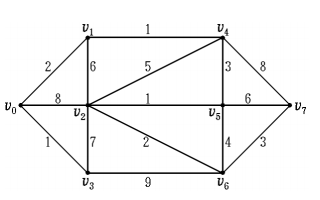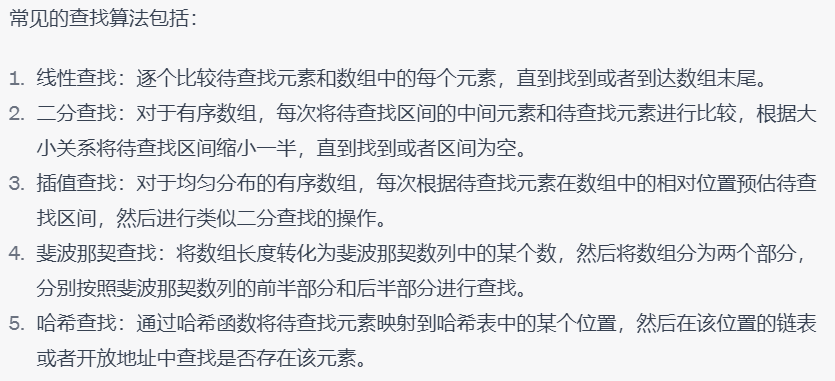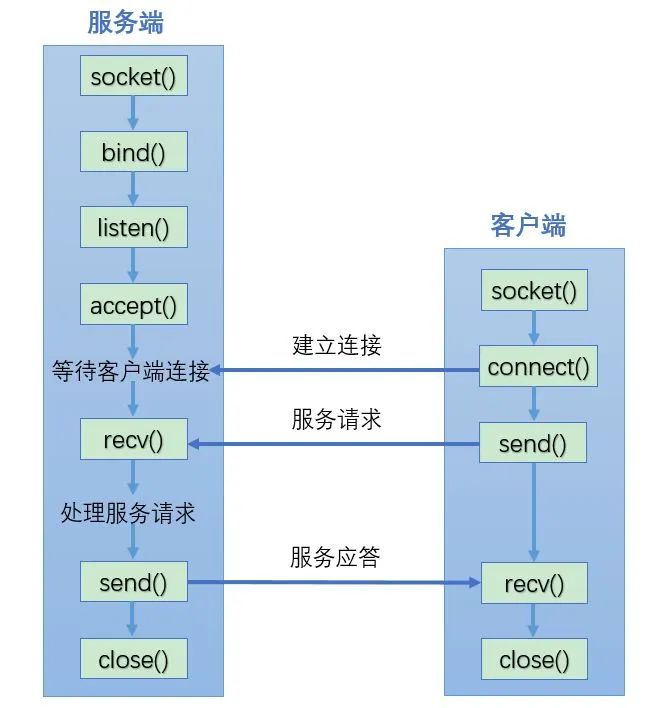6、樹表查找
6.1、基本原理
樹表查找(Tree-based Search)通常是一種利用有序樹結(jié)構(gòu)進(jìn)行查找的算法,基于二叉搜索樹(BST)或其它平衡二叉搜索樹(如AVL樹、紅黑樹)等數(shù)據(jù)結(jié)構(gòu)實(shí)現(xiàn)的查找算法。其基本原理是將查找值與樹中的某個(gè)節(jié)點(diǎn)進(jìn)行比較,根據(jù)比較結(jié)果,沿著樹的某個(gè)分支繼續(xù)向下查找,直到查找到目標(biāo)節(jié)點(diǎn)或者發(fā)現(xiàn)目標(biāo)節(jié)點(diǎn)不存在為止。
樹表查找的優(yōu)點(diǎn)是查找效率高,時(shí)間復(fù)雜度為 O(log n),其中 n 是節(jié)點(diǎn)的總數(shù)。它的主要缺點(diǎn)是需要維護(hù)樹的平衡性,增加和刪除節(jié)點(diǎn)會(huì)導(dǎo)致樹的平衡性被破壞,需要進(jìn)行旋轉(zhuǎn)操作來恢復(fù)平衡,這樣會(huì)增加操作的時(shí)間復(fù)雜度。
實(shí)現(xiàn)樹表查找算法,需要定義一個(gè)樹結(jié)構(gòu),每個(gè)節(jié)點(diǎn)包括一個(gè)鍵和一個(gè)值。鍵用于比較大小,值是存儲(chǔ)的數(shù)據(jù)。具體實(shí)現(xiàn)可以使用遞歸或者迭代的方式,對(duì)于每個(gè)節(jié)點(diǎn)進(jìn)行比較,并根據(jù)比較結(jié)果決定向左子樹或者右子樹繼續(xù)查找,直到找到目標(biāo)節(jié)點(diǎn)或者發(fā)現(xiàn)目標(biāo)節(jié)點(diǎn)不存在為止。
6.2、代碼示例
方法一:基于BST實(shí)現(xiàn)
#include
#include
// 定義二叉搜索樹節(jié)點(diǎn)結(jié)構(gòu)體
struct TreeNode {
int val;
struct TreeNode *left;
struct TreeNode *right;
};
// BST的插入操作
struct TreeNode* insert(struct TreeNode* root, int val) {
if (root == NULL) {
struct TreeNode* new_node = (struct TreeNode*)malloc(sizeof(struct TreeNode));
new_node->val = val;
new_node->left = NULL;
new_node->right = NULL;
return new_node;
} else {
if (val < root->val) {
root->left = insert(root->left, val);
} else if (val > root->val) {
root->right = insert(root->right, val);
}
return root;
}
}
// BST的查找操作
struct TreeNode* search(struct TreeNode* root, int val) {
if (root == NULL || root->val == val) {
return root;
} else if (val < root->val) {
return search(root->left, val);
} else {
return search(root->right, val);
}
}
// 中序遍歷BST(用于驗(yàn)證BST的正確性)
void inorderTraversal(struct TreeNode* root) {
if (root != NULL) {
inorderTraversal(root->left);
printf("%d ", root->val);
inorderTraversal(root->right);
}
}
int main() {
struct TreeNode* root = NULL;
root = insert(root, 5);
root = insert(root, 3);
root = insert(root, 7);
root = insert(root, 2);
root = insert(root, 4);
root = insert(root, 6);
root = insert(root, 8);
inorderTraversal(root); // 輸出:2 3 4 5 6 7 8
struct TreeNode* node = search(root, 6);
if (node != NULL) {
printf("找到了:%d\\n", node->val); // 輸出:找到了:6
} else {
printf("未找到\\n");
}
return 0;
}
該代碼定義了一個(gè)二叉搜索樹的結(jié)構(gòu)體TreeNode,包含了該節(jié)點(diǎn)的值val、左子節(jié)點(diǎn)指針left、右子節(jié)點(diǎn)指針right。同時(shí),實(shí)現(xiàn)了BST的插入和查找操作,其中插入操作是遞歸實(shí)現(xiàn)的,查找操作也是遞歸實(shí)現(xiàn)的。最后,利用中序遍歷函數(shù)inorderTraversal驗(yàn)證了BST的正確性,以及利用查找函數(shù)search查找了節(jié)點(diǎn)6。
方法二:基于紅黑樹
基于紅黑樹實(shí)現(xiàn)的樹表查找,也稱為紅黑樹查找,是一種高效的查找算法。紅黑樹是一種自平衡二叉查找樹,它具有以下特點(diǎn):
- 每個(gè)節(jié)點(diǎn)都有顏色,紅色或黑色;
- 根節(jié)點(diǎn)和葉子節(jié)點(diǎn)都是黑色;
- 如果一個(gè)節(jié)點(diǎn)是紅色,則它的子節(jié)點(diǎn)必須是黑色;
- 任何一條從根節(jié)點(diǎn)到葉子節(jié)點(diǎn)的路徑上,黑色節(jié)點(diǎn)的個(gè)數(shù)必須相同。
基于紅黑樹實(shí)現(xiàn)的樹表查找的實(shí)現(xiàn)過程如下:
- 構(gòu)建紅黑樹,將要查找的元素插入到紅黑樹中;
- 對(duì)紅黑樹進(jìn)行遍歷,查找需要的元素;
- 如果查找成功,返回該元素的位置;
- 如果查找失敗,返回空指針。
紅黑樹的插入和刪除操作都會(huì)改變樹的結(jié)構(gòu),因此在進(jìn)行插入和刪除操作時(shí)需要對(duì)紅黑樹進(jìn)行重新平衡。具體的平衡方法包括左旋、右旋、變色等操作,這些操作的目的是保持紅黑樹的平衡性和有序性。在進(jìn)行查找操作時(shí),根據(jù)紅黑樹的特點(diǎn)可以快速定位到目標(biāo)元素,從而實(shí)現(xiàn)高效的查找。
rbtree.h
#ifndef _RED_BLACK_TREE_H_
#define _RED_BLACK_TREE_H_
#define RED 0 // 紅色節(jié)點(diǎn)
#define BLACK 1 // 黑色節(jié)點(diǎn)
typedef int Type;
// 紅黑樹的節(jié)點(diǎn)
typedef struct RBTreeNode{
unsigned char color; // 顏色(RED 或 BLACK)
Type key; // 關(guān)鍵字(鍵值)
struct RBTreeNode *left; // 左孩子
struct RBTreeNode *right; // 右孩子
struct RBTreeNode *parent; // 父結(jié)點(diǎn)
}Node, *RBTree;
// 紅黑樹的根
typedef struct rb_root{
Node *node;
}RBRoot;
// 創(chuàng)建紅黑樹,返回"紅黑樹的根"!
RBRoot* create_rbtree();
// 銷毀紅黑樹
void destroy_rbtree(RBRoot *root);
// 將結(jié)點(diǎn)插入到紅黑樹中。插入成功,返回0;失敗返回-1。
int insert_rbtree(RBRoot *root, Type key);
// 刪除結(jié)點(diǎn)(key為節(jié)點(diǎn)的值)
void delete_rbtree(RBRoot *root, Type key);
// 前序遍歷"紅黑樹"
void preorder_rbtree(RBRoot *root);
// 中序遍歷"紅黑樹"
void inorder_rbtree(RBRoot *root);
// 后序遍歷"紅黑樹"
void postorder_rbtree(RBRoot *root);
// (遞歸實(shí)現(xiàn))查找"紅黑樹"中鍵值為key的節(jié)點(diǎn)。找到的話,返回0;否則,返回-1。
int rbtree_search(RBRoot *root, Type key);
// (非遞歸實(shí)現(xiàn))查找"紅黑樹"中鍵值為key的節(jié)點(diǎn)。找到的話,返回0;否則,返回-1。
int iterative_rbtree_search(RBRoot *root, Type key);
// 返回最小結(jié)點(diǎn)的值(將值保存到val中)。找到的話,返回0;否則返回-1。
int rbtree_minimum(RBRoot *root, int *val);
// 返回最大結(jié)點(diǎn)的值(將值保存到val中)。找到的話,返回0;否則返回-1。
int rbtree_maximum(RBRoot *root, int *val);
// 打印紅黑樹
void print_rbtree(RBRoot *root);
#endif
-
數(shù)據(jù)
+關(guān)注
關(guān)注
8文章
7139瀏覽量
89576 -
代碼
+關(guān)注
關(guān)注
30文章
4825瀏覽量
69046 -
查找算法
+關(guān)注
關(guān)注
0文章
6瀏覽量
5540
發(fā)布評(píng)論請(qǐng)先 登錄
相關(guān)推薦
TI資深工程師對(duì)無(wú)線連接技術(shù)經(jīng)驗(yàn)匯總、常見疑難問題詳細(xì)解答
簡(jiǎn)單的查找算法
isis 7 professional_元件查找代碼
圖論算法及MATLAB程序代碼的詳細(xì)資料說明

常見的查找算法匯總(含詳細(xì)代碼)1





 常見的查找算法匯總(含詳細(xì)代碼)3
常見的查找算法匯總(含詳細(xì)代碼)3












評(píng)論